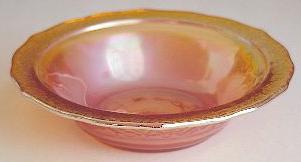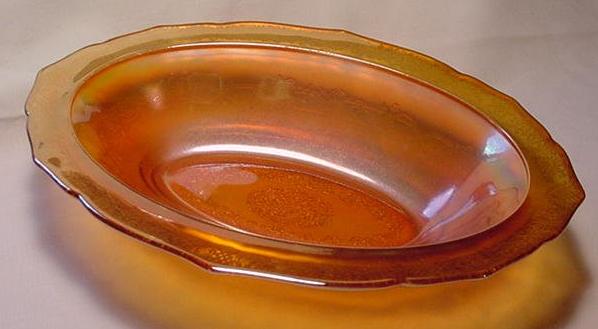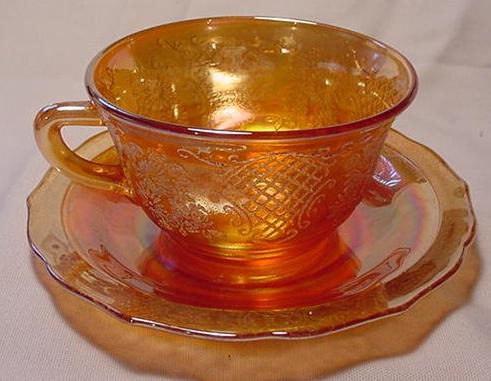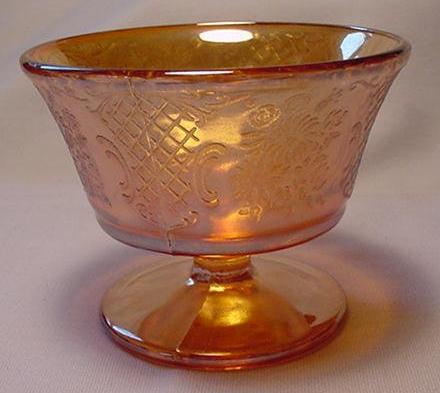

Normandie
Written by Rosemary Trietsch
My father collects Carnival glass, so I grew up surrounded by iridescence. I have vivid memories of him coming home with brown paper grocery bags that were sort of crumply looking and timeworn. But within these common sacks, under the layers of newspaper and dirt, were tumblers and bowls that had somehow managed to catch a piece of the rainbow. It was magical. One day, he came home with a wooden barrel filled with dinnerware that had rainbows on every piece, and though I don’t remember what we ate, I’ll never forget how wondrous the table looked when we used it. Now that I’m all grown up – or supposed to be – I have a name for the rainbow dishes: Normandie, by Federal Glass Company.
Every
time I put out a display of iridescent Normandie, I hear people who “know
about such things” explaining to their less learned companions how “this
shiny stuff is called ‘Carnival Glass’”. Depending upon how many times
I’ve heard it that day (and how annoying the ‘expert’ is,) I try to
educate them about what they’re looking at. Now, we Depression glass
collectors know that Normandie is not Carnival glass, but many of us are not
clear on the differences between the two. Carnival and Depression glass do have
a few things in common. Both were used as premiums in grocery stores and as
prizes in carnival games, and although similar style glass was made in other
parts of the world, the terms ‘Carnival glass’ and ‘Depression glass’
have come to refer to glass made in the United States during a certain time
period. Now let’s get to the differences.
Carnival
glass is older than Depression glass. It is “colored, pressed glass with
surface iridescence fired on, made in America between 1900 – 1925.” (This is
the definition Marion Hartung gives in her “First Book of Carnival Glass”
1960. Hartung is to Carnival what Weatherman is to Depression, and her books are
known as the definitive reference works for Carnival glass pattern
identification.) Making Carnival glass was a two step process. First, the glass
was pressed in the molds. After it was done, metallic salts were sprayed onto
the pieces and they were re-fired, resulting in the iridescent finish. Different
effects were achieved by varying the color of the underlying glass and the
combination of metallic elements.
Iridescent Depression glass was produced the same way with one major difference: Depression glass was made entirely by machine while each piece of Carnival glass was sprayed and finished by hand. This difference might not seem like anything at first, but it’s very important when you think about it. Because each piece of Carnival glass was hand worked, you’ll find variation even on two ‘identical’ pieces. This is desirable because Carnival glass was made primarily in decorative items. A collector may have the piece already, but can always search for one with a more pleasing iridescence or color variation that goes with his decor. With Depression glass, the opposite is true: variation drives us crazy – just ask anyone who’s trying to match the pink of his Cherry Blossom dishes. If you’re making dinnerware, it’s important to be able to produce a consistent product over the entire production period, so that the dishes you add today match the ones purchased years ago. The switch to automation that took place in glass factories during the 1920’s made this consistency possible.


Federal
Glass Company was among the first to recognize the demand for economical
glassware and was quick to capitalize on it. Among the first fully automated
glass factories, they produced large quantities of machine-made glass dinnerware
during the Depression years, and continue glass production today. Normandie was
produced from 1933 to 1940 - during
the same time that Madrid, Patrician, and Sharon were made. Although it’s
available in amber and pink, iridescent Normandie – known as Sunburst – is
the most commonly found color. (Federal seemed to be saving the amber and pink
glass for their other patterns. Though harder to find, pink and amber Normandie
are beautiful, so if you like the pattern, but don’t like iridescent glass,
try one of these other ‘flavors’. It’s worth the hunt.) In fact, Normandie
is the only Depression era dinnerware that can be found in iridescent and it has
caused much confusion among glass collectors – Depression AND Carnival.
(Remember that iridescent Iris and Anniversary date to the 1950’s.)
Iridescent Normandie was recognized by Carnival collectors years before Weatherman published her first Depression glass books. In her Third Book of Carnival Glass (1962), Hartung lists it as “Bouquet and Lattice, and has this to say about it:
“This
pattern has been included here because of the numerous inquiries about it that
have been received.
Certainly,
it is indeed a late comer to the Carnival family, dating into the 1920’s.
However, we know that occasional pieces and patterns were made later than
that…so this is no later than other patterns we find quite collectible. If you
find it pleasing, why not collect it? Certainly it is easier to find than many
others, and was made in forms and shapes unheard of in an earlier day. One
example of this is an eleven-inch divided or sectional plate – very practical
for a salad luncheon at least.
The iridescent pieces have
been seen only in marigold. These have usually have a slick look and are apt to
be shiny. Still, if you like it, Why not?”
Hartung recognized that while it’s a bit late to be ‘real’ Carnival and isn’t of the same quality, it certainly is an acceptable ‘go with’ as Carnival dinnerware wasn’t originally made. Carnival collectors fell into two camps: those who agreed with Hartung’s comments, and those who saw iridescent Normandie as a later, cheaper imitation of the real thing.
When Weatherman published Book One in 1970, she had this to say about Normandie:
“Normandie is the official name for this beautifully wrought, mold-etched design of Federal’s. It was not from an old Carnival mold as is widely believed, but was made especially for the new pink mold-etched glassware that was coming in vogue. It was first made in 1933 in “Rose Glow” and crystal. A year later a color called “Sunburst” was created by spraying an iridescent amber onto the patterned crystal ware and then firing in on so well that some people today might think it true Carnival glass. Traincarloads of this Normandie in Sunburst were shipped to the Great Northern Products Company to be used as premiums.”


Remember that all this information was coming to
light in the 1960’s. Jeanette Glass had just reissued Iris and Anniversary in
iridescent, and companies like Indiana and Fenton were pushing reproduction
Carnival glass to take advantage of the market trend. All the new glass had the
same “too shiny, fake-looking” iridescence and Normandie was quickly
confused with this new stuff. Carnival collectors were up in arms trying to keep
up with all the new junk while protecting the integrity of the old. Depression
glass collectors saw anything iridescent as “that new Carnival stuff” and
wanted nothing to do with it, never realizing that true Depression glass lay
among the junk. Of course, in the 1960’s, Depression glass was not even
recognized as collectible. It wasn’t until the 1970’s that the research
started to congeal. If you think about it, Carnival collectors went through
their ‘repro scare’ in the 1950’s – 70’s, while ours began in the
1970’s and is going on into the present day.
Considering that Carnival glass is about 20 years older than Depression
glass, the cycle is right on course.
So here we are, over thirty years later, and how
far have we come? Well, some people are still confusing iridescent Normandie
with Carnival glass, but those that do are quick to grasp the difference when
you explain it to them. Carnival glass collectors are happy that much of the
confusion is cleared up, and don’t mind adding Normandie dinnerware to their
collections. Depression glass collectors are happy that iridescent Normandie is
finally recognized for what it is, and hunt fervently for serving pieces and
plain dinner plates. (Grills are
very common, plain dinners and serving pieces are hard to find, and the 8 inch
salad plate is invisible.) Personally, I’ve always liked iridescent Normandie.
It’s lovely on the table – especially at Thanksgiving – and it brings me
good memories. In my own collecting, I try to follow Jefferson’s advice to
“Surround yourself only with things you know to be useful or think to be
beautiful.” I think that covers all the bases, don’t you?
Sources:
Marion T. Hartung; First book of Carnival Glass, 1960
T
Hazel Marie Weatherman; Colored Glassware of the Depression Era, Book 1, 1970
Book 2, 1974